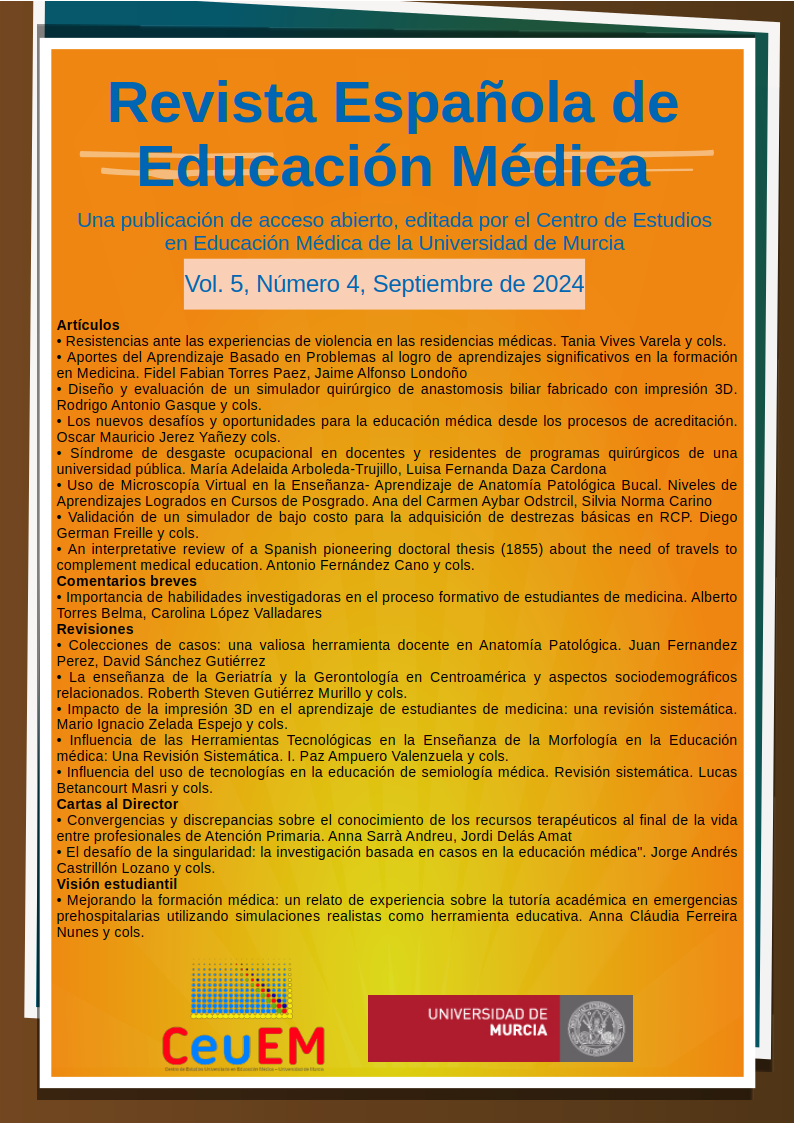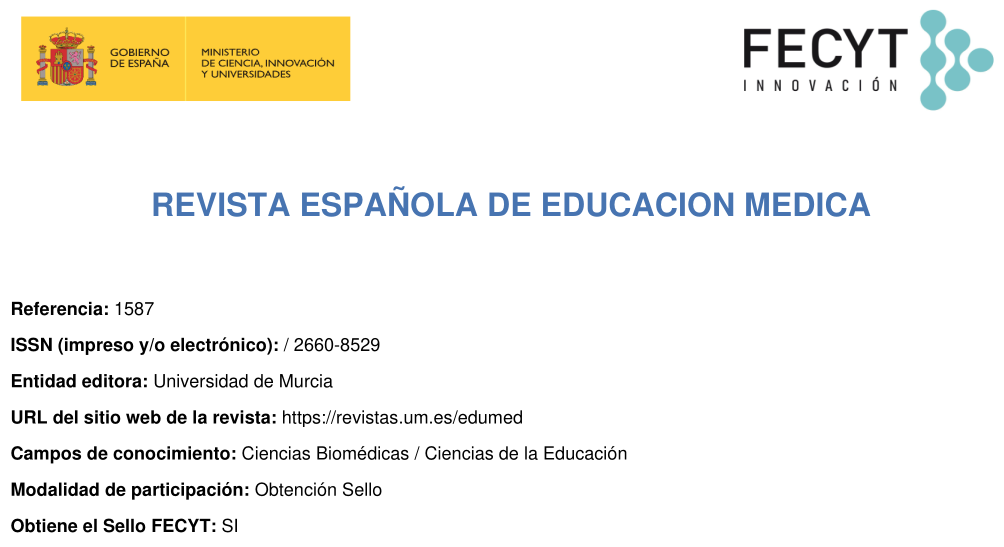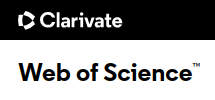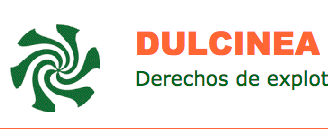Impacto de la impresión 3D en el aprendizaje de estudiantes de medicina: una revisión sistemática.
Resumen
El uso de la impresión 3D se ha difundido en diversas áreas, incluyendo la enseñanza de la medicina, desde su apoyo para el estudio de anatomía humana hasta en el entrenamientos de técnicas quirúrgicas dado los beneficios del aprendizaje por “Hands-On-Learning”. El objetivo de la presente investigación es esclarecer el impacto de la impresión 3D sobre el aprendizaje de estudiantes de medicina, así como determinar en qué áreas de su currículum ha sido implementada. Para ello, se realizó una revisión sistemática de la literatura disponible. Las bases de datos usadas fueron PubMed, CINAHL, PsycINFO, ERIC, Web of Science y SCOPUS, usando los siguientes 4 conceptos: “3D Printing” AND “Medical Education” AND “Outcome of Education” AND “Higher Education”. Se consideraron publicaciones en inglés y español. Se identificaron 3.326 estudios hasta Octubre 2023 (705 duplicados). Mediante el protocolo PRISMA 2020 y el software COVIDENCE, cuatro autores revisaron los resultados y seleccionaron aquellos acordes a criterios de inclusión y exclusión. 2561 estudios fueron excluidos, identificándose 60 estudios para lectura de texto completo. De estos, 34 cumplieron criterios de inclusión propuestos, siendo finalmente revisados y sintetizados por los autores. Entre los hallazgos, se destaca una tendencia a investigar el rol educativo de la impresión 3D en áreas de anatomía, diversas patologías, radiología y simulación. Al comparar la impresión 3D con modelos 2D se evidenció mejores puntuaciones post-intervención del grupo 3D. En cuanto a modelos cadavéricos, nuevamente la impresión 3D muestra mejores resultados en aprendizaje anatómico, aunque también hubo estudios que no evidenciaron diferencias significativas, sin embargo, ninguno reportó inferioridad de la impresión 3D como herramienta didáctica. Por último, se encontró un número limitado de estudios sobre su impacto en el aprendizaje a largo plazo. La Impresión 3D evidencia tener un impacto positivo en el aprendizaje en diversas áreas de la formación médica.
Descargas
Métricas
-
Resumen1144
-
pdf701
-
pdf 701
Citas
Fleming C, Sadaghiani MS, Stellon MA, Javan R. Effectiveness of Three-Dimensionally Printed Models in Anatomy Education for Medical Students and Resident Physicians: Systematic Review and Meta-Analysis. J Am Coll Radiol JACR. 2020 Oct;17(10):1220–9. https://doi.org/10.1016/j.jacr.2020.05.030
Chytas D, Johnson EO, Piagkou M, Tsakotos G, Babis GC, Nikolaou VS, et al. Three-dimensional printing in anatomy teaching: current evidence. Surg Radiol Anat. 2020 Jul 1;42(7):835–41. https://doi.org/10.1007/s00276-020-02470-2
Leung G, Pickett AT, Bartellas M, Milin A, Bromwich M, Shorr R, et al. Systematic review and meta-analysis of 3D-printing in otolaryngology education. Int J Pediatr Otorhinolaryngol. 2022 Apr 1;155:111083. https://doi.org/10.1016/j.ijporl.2022.111083
Brumpt E, Bertin E, Tatu L, Louvrier A. 3D printing as a pedagogical tool for teaching normal human anatomy: a systematic review. BMC Med Educ. 2023 Oct 20;23(1):783. https://doi.org/10.1186/s12909-023-04744-w
O’Brien C, Souza CA, Sheikh A, Miguel O, Wood T. Use of tracheobronchial tree 3-dimensional printed model: does it improve trainees’ understanding of segmentation anatomy? A prospective study. 3D Print Med. 2021 Jan 6;7(1):2. https://doi.org/10.1186/s41205-020-00092-3
Asif A, Lee E, Caputo M, Biglino G, Shearn AIU. Role of 3D printing technology in paediatric teaching and training: a systematic review. BMJ Paediatr Open. 2021 Dec;5(1):e001050. https://doi.org/10.1136/bmjpo-2021-001050
Ye Z, Jiang H, Bai S, Wang T, Yang D, Hou H, et al. Meta-analyzing the efficacy of 3D printed models in anatomy education. Front Bioeng Biotechnol. 2023 Feb 20;11:1117555. https://doi.org/10.3389/fbioe.2023.1117555
Schwartz DL, Tsang JM, Blair KP. The ABCs of how we learn: 26 scientifically proven approaches, how they work, and when to use them. First edition. New York, NY: W.W. Norton & Company, Inc; 2016. 367 p. (Norton books in education).
Page MJ, McKenzie JE, Bossuyt PM, Boutron I, Hoffmann TC, Mulrow CD, et al. The PRISMA 2020 statement: an updated guideline for reporting systematic reviews. BMJ. 2021 Mar 29;372:n71. https://doi.org/10.1186/s13643-021-01626-4
Lim KHA, Loo ZY, Goldie SJ, Adams JW, McMenamin PG. Use of 3D printed models in medical education: A randomized control trial comparing 3D prints versus cadaveric materials for learning external cardiac anatomy. Anat Sci Educ. 2016 May 6;9(3):213–21. https://doi.org/10.1002/ase.1573
Mogali SR, Chandrasekaran R, Radzi S, Peh ZK, Tan GJS, Rajalingam P, et al. Investigating the effectiveness of three‐dimensionally printed anatomical models compared with plastinated human specimens in learning cardiac and neck anatomy: A randomized crossover study. Anat Sci Educ. 2022 Nov;15(6):1007–17. https://doi.org/10.1002/ase.2128
Kong X, Nie L, Zhang H, Wang Z, Ye Q, Tang L, et al. Do 3D Printing Models Improve Anatomical Teaching About Hepatic Segments to Medical Students? A Randomized Controlled Study. World J Surg. 2016 Aug;40(8):1969–76. https://doi.org/10.1007/s00268-016-3541-y
Chen S, Pan Z, Wu Y, Gu Z, Li M, Liang Z, et al. The role of three-dimensional printed models of skull in anatomy education: a randomized controlled trail. Sci Rep. 2017 Apr 3;7(1):575. https://doi.org/10.1038/s41598-017-00647-1
Yang MY, Tseng HC, Liu CH, Tsai SY, Chen JH, Chu YH, et al. Effects of the individual three-dimensional printed craniofacial bones with a quick response code on the skull spatial knowledge of undergraduate medical students. Anat Sci Educ. 2023;16(5):858–69. https://doi.org/10.1002/ase.2269
Tanner JA, Jethwa B, Jackson J, Bartanuszova M, King TS, Bhattacharya A, et al. A Three‐Dimensional Print Model of the Pterygopalatine Fossa Significantly Enhances the Learning Experience. Anat Sci Educ. 2020 Sep;13(5):568–80. https://doi.org/10.1002/ase.1942
Yi X, Ding C, Xu H, Huang T, Kang D, Wang D. Three-Dimensional Printed Models in Anatomy Education of the Ventricular System: A Randomized Controlled Study. World Neurosurg. 2019 May;125:e891–901. https://doi.org/10.1016/j.wneu.2019.01.204
Chen Y, Qian C, Shen R, Wu D, Bian L, Qu H, et al. 3D Printing Technology Improves Medical Interns’ Understanding of Anatomy of Gastrocolic Trunk. J Surg Educ. 2020 Sep;77(5):1279–84. https://doi.org/10.1016/j.jsurg.2020.02.031
Li Z, Li Z, Xu R, Li M, Li J, Liu Y, et al. Three-dimensional printing models improve understanding of spinal fracture—A randomized controlled study in China. Sci Rep. 2015 Jun 23;5(1):11570. https://doi.org/10.1038/srep11570
Yan M, Huang J, Ding M, Wang J, Ni J, Wu H, et al. Three-Dimensional Printing Model Enhances Correct Identification and Understanding of Pelvic Fracture in Medical Students. J Surg Educ. 2023 Mar 1;80(3):331–7. https://doi.org/10.1016/j.jsurg.2022.10.016
Wu AM, Wang K, Wang JS, Chen CH, Yang XD, Ni WF, et al. The addition of 3D printed models to enhance the teaching and learning of bone spatial anatomy and fractures for undergraduate students: a randomized controlled study. Ann Transl Med. 2018 Oct;6(20):403–403. https://doi.org/10.21037%2Fatm.2018.09.59
Ebbing J, Jäderling F, Collins JW, Akre O, Carlsson S, Höijer J, et al. Comparison of 3D printed prostate models with standard radiological information to aid understanding of the precise location of prostate cancer: A construct validation study. PLOS ONE. 2018 Jun 25;13(6):e0199477. https://doi.org/10.1371/journal.pone.0199477
Youman S, Dang E, Jones M, Duran D, Brenseke B. The Use of 3D Printers in Medical Education with a Focus on Bone Pathology. Med Sci Educ. 2021 Apr 1;31(2):581–8. https://doi.org/10.1007%2Fs40670-021-01222-0
Su W, Xiao Y, He S, Huang P, Deng X. Three-dimensional printing models in congenital heart disease education for medical students: a controlled comparative study. BMC Med Educ. 2018 Dec;18(1):178. https://doi.org/10.1186/s12909-018-1293-0
Lau I, Sun Z. The role of 3D printed heart models in immediate and long-term knowledge acquisition in medical education. Rev Cardiovasc Med. 2022 Jan 17;23(1):1. https://doi.org/10.31083/j.rcm2301022
Karsenty C, Guitarte A, Dulac Y, Briot J, Hascoet S, Vincent R, et al. The usefulness of 3D printed heart models for medical student education in congenital heart disease. BMC Med Educ. 2021 Dec;21(1):480. https://doi.org/10.1186/s12909-021-02917-z
Wang Z, Liu Y, Luo H, Gao C, Zhang J, Dai Y. Is a Three-Dimensional Printing Model Better Than a Traditional Cardiac Model for Medical Education? A Pilot Randomized Controlled Study. Acta Cardiol Sin. 2017 Nov;33(6):664–9. https://doi.org/10.6515%2FACS20170621A
Wu C, Luo M, Liu Y, Dai R, Zhang M, Zhong Y, et al. Application of a 3D-printed eye model for teaching direct ophthalmoscopy to undergraduates. Graefes Arch Clin Exp Ophthalmol. 2022 Jul 1;260(7):2361–8. https://doi.org/10.1007/s00417-021-05538-w
Smith CF, Tollemache N, Covill D, Johnston M. Take away body parts! An investigation into the use of 3D‐printed anatomical models in undergraduate anatomy education. Anat Sci Educ. 2018 Jan;11(1):44–53. https://doi.org/10.1002/ase.1718
Lane JC, Black JS. Modeling Medical Education: The Impact of Three-Dimensional Printed Models on Medical Student Education in Plastic Surgery. J Craniofac Surg. 2020 Jun;31(4):1018. https://doi.org/10.1097/scs.0000000000006567
Al-Badri N, Touzet-Roumazeille S, Nuytten A, Ferri J, Charkaluk ML, Nicot R. Three-dimensional printing models improve long-term retention in medical education of pathoanatomy: A randomized controlled study. Clin Anat. 2022;35(5):609–15. https://doi.org/10.1002/ca.23878
AlAli AB, Griffin MF, Calonge WM, Butler PE. Evaluating the Use of Cleft Lip and Palate 3D-Printed Models as a Teaching Aid. J Surg Educ. 2018 Jan 1;75(1):200–8. https://doi.org/10.1016/j.jsurg.2017.07.023
Nicot R, Druelle C, Chazard E, Roland-Billecart T, Nuytten A, Richard F, et al. Three-Dimensional Printing Model Enhances Craniofacial Trauma Teaching by Improving Morphologic and Biomechanical Understanding: A Randomized Controlled Study. Plast Reconstr Surg. 2022 Mar;149(3):475e–84e. https://doi.org/10.1097/prs.0000000000008869
Cai B, Rajendran K, Bay BH, Lee J, Yen C. The Effects of a Functional Three‐dimensional (3D) Printed Knee Joint Simulator in Improving Anatomical Spatial Knowledge. Anat Sci Educ. 2019 Nov;12(6):610–8. https://doi.org/10.1002/ase.1847
Ben Awadh A, Clark J, Clowry G, Keenan ID. Multimodal Three-Dimensional Visualization Enhances Novice Learner Interpretation of Basic Cross-Sectional Anatomy. Anat Sci Educ. 2022 Jan;15(1):127–42. https://doi.org/10.1002/ase.2045
Hojo D, Murono K, Nozawa H, Kawai K, Hata K, Tanaka T, Oba K, Ishihara S. Utility of a Three-Dimensional Printed Pelvic Model for Lateral Pelvic Lymph Node Dissection Education: A Randomized Controlled Trial. J Am Coll Surg. 2019 Dec; 229(6): 552-559.e3. https://doi.org/10.1016/j.jamcollsurg.2019.08.1443
Derechos de autor 2024 Servicio de Publicaciones de la Universidad de Murcia

Esta obra está bajo una licencia internacional Creative Commons Atribución-NoComercial-SinDerivadas 4.0.
Las obras que se publican en esta revista están sujetas a los siguientes términos:
1. El Servicio de Publicaciones de la Universidad de Murcia (la editorial) conserva los derechos patrimoniales (copyright) de las obras publicadas y favorece y permite la reutilización de las mismas bajo la licencia de uso indicada en el punto 2.
© Servicio de Publicaciones, Universidad de Murcia
2. Las obras se publican bajo una licencia Creative Commons Reconocimiento-NoComercial-SinObraDerivada 4.0.
![]()
3. Condiciones de auto-archivo. Se permite y se anima a los autores a difundir electrónicamente las versiones preprint (versión antes de ser evaluada y enviada a la revista) y/o post-print (versión evaluada y aceptada para su publicación) de sus obras antes de su publicación, ya que favorece su circulación y difusión más temprana y con ello un posible aumento en su citación y alcance entre la comunidad académica.




















